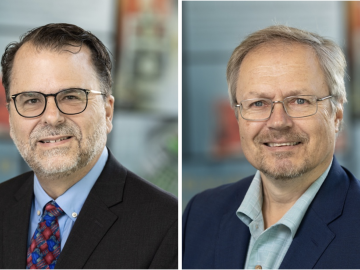
Filter News
Area of Research
- (-) Clean Energy (525)
- (-) Fuel Cycle Science and Technology (3)
- (-) Materials (433)
- (-) Supercomputing (313)
- Advanced Manufacturing (34)
- Biological Systems (18)
- Biology and Environment (179)
- Biology and Soft Matter (5)
- Building Technologies (12)
- Chemical and Engineering Materials (4)
- Chemistry and Physics at Interfaces (11)
- Climate and Environmental Systems (14)
- Computational Biology (6)
- Computational Chemistry (5)
- Computational Engineering (5)
- Computer Science (19)
- Data (1)
- Earth Sciences (1)
- Electricity and Smart Grid (3)
- Energy Frontier Research Centers (14)
- Energy Sciences (5)
- Fossil Energy (3)
- Functional Materials for Energy (16)
- Fusion and Fission (55)
- Fusion Energy (19)
- Geographic Information Science and Technology (3)
- Isotope Development and Production (3)
- Isotopes (36)
- Materials Characterization (2)
- Materials for Computing (36)
- Materials Synthesis from Atoms to Systems (13)
- Materials Under Extremes (12)
- Mathematics (1)
- National Security (81)
- Neutron Data Analysis and Visualization (4)
- Neutron Science (192)
- Nuclear Science and Technology (74)
- Nuclear Systems Modeling, Simulation and Validation (3)
- Nuclear Systems Technology (1)
- Quantum Condensed Matter (4)
- Quantum information Science (9)
- Reactor Technology (1)
- Renewable Energy (4)
- Sensors and Controls (5)
- Transportation Systems (11)
News Type
News Topics
- 3-D Printing/Advanced Manufacturing (90)
- Advanced Reactors (10)
- Artificial Intelligence (42)
- Big Data (25)
- Bioenergy (33)
- Biology (20)
- Biomedical (25)
- Biotechnology (6)
- Buildings (39)
- Chemical Sciences (33)
- Clean Water (10)
- Climate Change (36)
- Composites (19)
- Computer Science (109)
- Coronavirus (26)
- Critical Materials (21)
- Cybersecurity (14)
- Decarbonization (36)
- Energy Storage (87)
- Environment (78)
- Exascale Computing (25)
- Fossil Energy (2)
- Frontier (29)
- Fusion (8)
- Grid (43)
- High-Performance Computing (43)
- Hydropower (2)
- Irradiation (1)
- Isotopes (14)
- ITER (1)
- Machine Learning (19)
- Materials (99)
- Materials Science (95)
- Mathematics (3)
- Mercury (3)
- Microelectronics (1)
- Microscopy (31)
- Molten Salt (3)
- Nanotechnology (43)
- National Security (12)
- Net Zero (4)
- Neutron Science (49)
- Nuclear Energy (27)
- Partnerships (16)
- Physics (35)
- Polymers (22)
- Quantum Computing (20)
- Quantum Science (33)
- Renewable Energy (1)
- Security (10)
- Simulation (17)
- Software (1)
- Space Exploration (8)
- Statistics (1)
- Summit (44)
- Sustainable Energy (73)
- Transformational Challenge Reactor (5)
- Transportation (74)
Media Contacts

The Summit supercomputer, once the world’s most powerful, is set to be decommissioned by the end of 2024 to make way for the next-generation supercomputer. Over the summer, crews began dismantling Summit’s Alpine storage system, shredding over 40,000 hard drives with the help of ShredPro Secure, a local East Tennessee business. This partnership not only reduced costs and sped up the process but also established a more efficient and secure method for decommissioning large-scale computing systems in the future.

Stephen Kowalski and Mikael Salonvaara received the Distinguished Service Award, which salutes members who have served the society with distinction in chapter, regional and society activities.

Three transportation researchers at the Department of Energy’s Oak Ridge National Laboratory have been elevated to senior member grade of the Institute of Electrical and Electronics Engineers, or IEEE.

Kashif Nawaz, distinguished researcher and section head for Building Technologies Research at the Department of Energy’s Oak Ridge National Laboratory, has been named a Fellow of the American Society of Mechanical Engineers, or ASME.

Nuclear physicists at the Department of Energy’s Oak Ridge National Laboratory recently used Frontier, the world’s most powerful supercomputer, to calculate the magnetic properties of calcium-48’s atomic nucleus.

A collection of seven technologies for lithium recovery developed by scientists from ORNL has been licensed to Element3, a Texas-based company focused on extracting lithium from wastewater produced by oil and gas production.

Electric vehicles can drive longer distances if their lithium-ion batteries deliver more energy in a lighter package. A prime weight-loss candidate is the current collector, a component that often adds 10% to the weight of a battery cell without contributing energy.

It would be a challenge for any scientist to match Alexey Serov’s rate of inventions related to green hydrogen fuel. But this researcher at ORNL has 84 patents with at least 35 more under review, so his electrifying pace is unlikely to slow down any time soon.

Researchers at ORNL became the first to 3D-print large rotating steam turbine blades for generating energy in power plants.

For years, Duane Starr led workshops at ORNL to help others from across the U.S. government understand uranium processing technologies. After his retirement, Starr donated a 5-foot-tall working model, built in his garage, that demonstrates vibration harmonics, consistent with operation of a super critical gas centrifuge rotor, a valuable resource to ongoing ORNL-led workshops.


